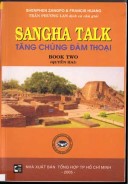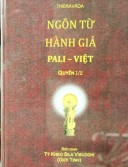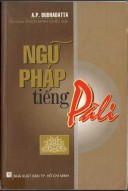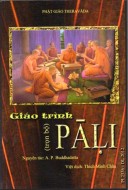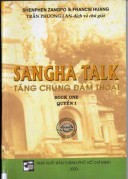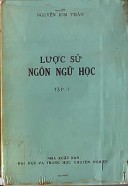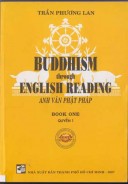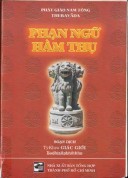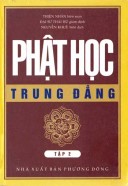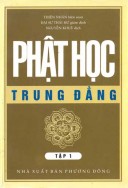Tìm Sách
Ngôn Ngữ >> SANGHA TALK Tăng chúng đàm thoại II
Thông tin tra cứu
- Tên sách : SANGHA TALK Tăng chúng đàm thoại II
- Tác giả : Shenphen Zangpo & Francis Huang
- Dịch giả : Trần Phương Lan
- Ngôn ngữ : Anh - Việt
- Số trang : 149
- Nhà xuất bản : TP. Hồ Chí Minh
- Năm xuất bản : 2005
- Phân loại : Ngôn Ngữ
- MCB : 12010000006917
- OPAC :
- Tóm tắt :
SANGHA TALK
TĂNG CHÚNG ĐÀM THOẠI II
Advanced Level
Shenphen Zangpo & Francis Huang
Trần Phương Lan
PREFACE
After beginning teaching conversational English at Buddhist Institutes in Taiwan, it became apparent that there was a lack of suitable teaching material. I thought to design a textbook series specifically aimed at introducing basic Buddhist terminology along with conversational English that could be used to teach the Sangha, but resolve to actually put it to print didn’t come until visiting India in 1995.
There I met other teachers who, like myself, were using conventional textbooks and a lot of improvisation. They encouraged me to begin the project. This book is the result of their encouragement.
The West desperately needs competent Dharma teachers who can speak English. I hope that in a small way this text may help fulfill this need.
THEME OF THE TEXT
The text is based on a group of Buddhist monks and nuns attending an international Buddhist institute. Through a conversational story line, grammar, conversational expressions, and Buddhist terminology are introduced.
LAYOUT OF THE TEXT
The textbooks are divided into three volumes – Volume One for beginner level students, Volume Two for intermediate level students, and this third volume for advanced level students. Each part contains twelve units and each unit consists of the following sections:
1. Dialogue
2. Points of Practice
3. Complete the blank.
4. Choose the correct answer.
5. Homework exercises based on the dialogue (Units three to Nine); Contract a dialogue (Units Ten to Twelve).
6. Comprehension / discussion exercise.
In Unit One, a teaching plan is given as an example of how to use the text. Ideally, a cassette should be used for the dialogue. If you are in a position to make one (six male and three female native speakers would be required), I suggest that you do so.
THE TEXT AND THE SUDENTT
Basically this text book is aimed at the “false starter” – i.e. a student who has received some formal instruction in English but needs to have what he has learn put into a conversational context. For total beginner, the stories that conclude each chapter may prove too challenging and can be omitted. For these students, basic grammar will also have to be taught along with the dialogues. Finally, those students who can already speak quite well, but lack knowledge of Buddhist related vocabulary, can concentrate on the stories; the dialogues can be either totally omitted or just taught when there is deemed a need.
CLASS MATERIAL AND TEACHING ADVICE
Before starting Unit One, introduce the main characters in the dialogues using the information on p. VI. If you have word atlas, together with the students, locate where the characters are from. This will make the people in the dialogues more real, and in this way will enhance the interest of the students. Also, after completing or when beginning the comprehension exercises, introduce the author to the students using the information on p. viii. Ask the students if they were familiar with the author. If they are, encourage them to supply more information about him.
The dialogue has one primary function: to increase the students’ listening ability and the most effective way to do this is to give students something specific to listen for. So, before beginning the dialogue, the teacher should have the students look through the four questions that are given at the end of the dialogue. (Note: The aim of these exercises is not to test the students, but to give them a point of focus). In a large class, it may be a good idea to arrange the students in small groups of four or five to discuss the questions. (The teacher should teach them useful sentences such as, “What did you get for number one?” or “Did he say_____or____?” etc.). The dialogue should then be played (or read by the teacher if no cassette has been made --- in this case, the teacher must use pictures or objects to clearly indicate who is speaking). The students may look at the pictures related to the dialogue, but not the dialogue itself, and after they have heard it through once, the teacher should ask them the questions. If they get them all correct, have them look through the second set of four questions and then repeat the process. If they couldn’t get them, play the cassette again. If they are still unable to reach the answers, only the sentences pertinent to the questions should be played (several times if necessary) and have them pieced the answers together as a group effort. Only after the dialogue has been fully comprehended through listening should the students be allowed to read it.
From Units Tree to Nine, the dialogues take a student-teacher, questions and answer format, and I have tried to answer the questions according to the tradition that the teacher belongs. If these answers contradict your student’ understanding, then don’t waste the opportunity to set up a debate. Divide the class into several groups, with one side representing the teacher’s ideology and the other side representing their own interpretation. If possible, have the “defending” team (s) research the tradition of the school that they will represent in the debate.
When looking at cartoons, the teacher should ask such questions as, “How does he/she look?” “It he/she happy? Frightened?”, “What is he/she thinking?” The cartoons can be a good means to introduce vocabulary related to emotions. Use them imaginatively.
It’s also recommended that before beginning a new unit the previous unit be reviewed briefly, and after the completion of six units a reviewed test be given covering all the main point so far studied. Further, if it is known that the teacher periodically gives unannounced review tests, this will keep the students on their toes. (The teacher randomly asking questions or using flash cards to get the students to do so is sufficient. A written test is not necessary). Unless students are in a situation where English can be used out of class, there is a tendency to concentrate on what is presently being studied and, as a result, what has been learnt is forgotten. This method should help eliminate or at least reduce this problem.
Finally, suggest that students make their daily mental plans in English; when they meet situations that they cannot express in English, they should either check how to do so immediately or make a note and ask their teacher next class. In this way, they will build up both their vocabulary and fluency in speaking.
ShenphenZangpo
Taipei
Summer, 2000
Contents
Unit One
Dialogue Where does the bus depart from?
Unit Two
Dialogue I woke up this morning feeling terrible.
Unit Three
Dialogue What is a Bodhisattva?
Unit Four
Dialogue I’d like to ask you about the Four Noble Truths.
Unit Five
Dialogue Suffering exists because of delusion and ignorance.
Unit Six
Dialogue “Karma” literally means action.
Unit Seven
Dialogue Bodhicitta actually has two aspects: relative and absolute.
Unit Eight
Dialogue All phenomena are merely elements that temporarily bind together
Unit Nine
Dialogue We should deeply understand the principle of impermanence.
Unit Ten
Dialogue My teacher passed away last night.
Unit Eleven
Dialogue Please keep in touch.
Unit Twelve
Dialogue I know he has looking forward to going there someday.
 Facebook
Facebook
 Google
Google
 Google+
Google+
